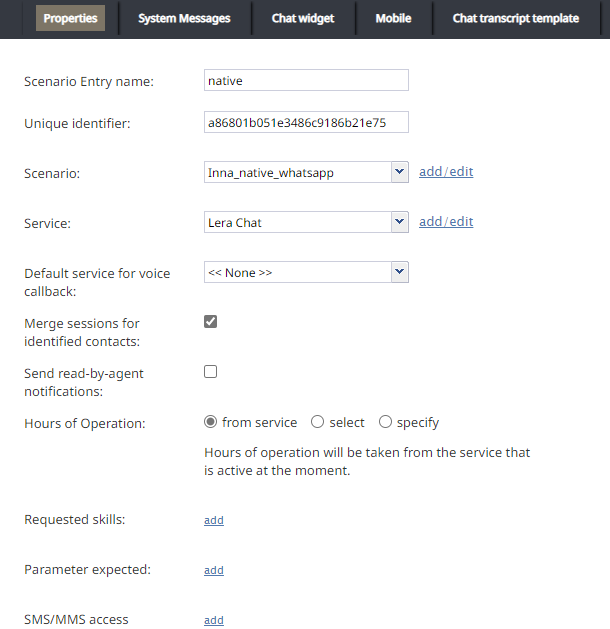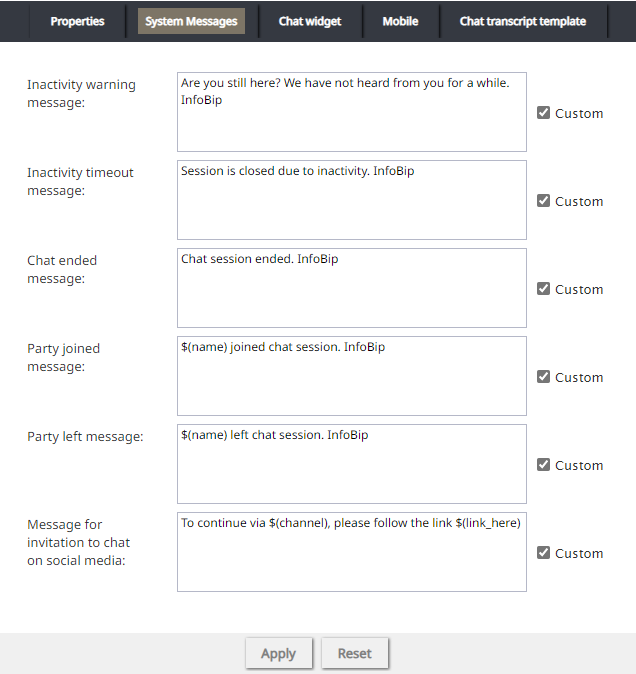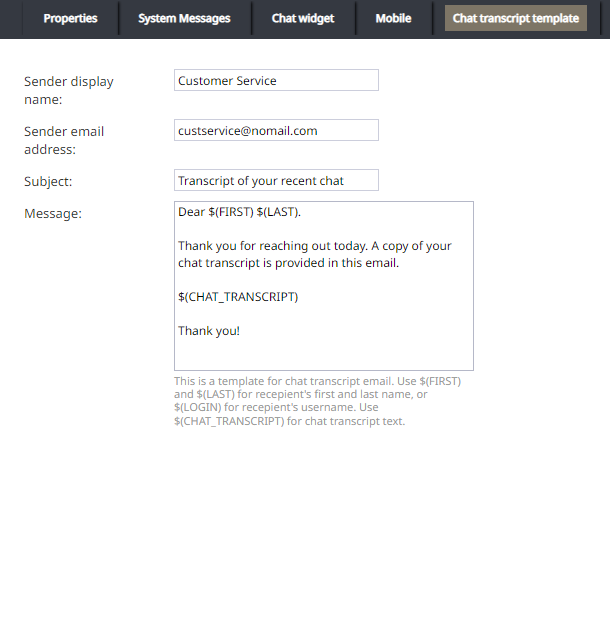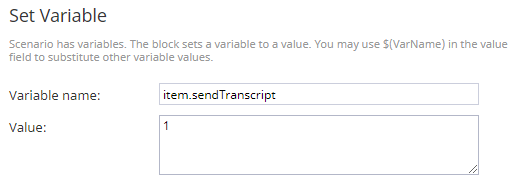Messaging/Chat Scenario Entries
Scenario Entries > Messaging/Chat
Messaging/Chat scenario entries are used to associate scenarios with contacts requested via mobile and web applications.
Messaging/Chat Scenario Entries Screen Properties
Scenario Entries > Messaging/Chat/Properties
The Messaging/Chat Scenario Entries screen properties are described as follows.
- Name
- The name of this messaging/chat scenario entry. This field is mandatory and must be unique within the contact center.
- Unique identifier
- The Unique identifier is generated by the system for this scenario entry. This identifier must be used as Application ID in the mobile and/or web applications that will connect to your contact center via this scenario entry. For more information, see section General Information of the Bright Pattern Mobile/Web API Specification.
- Scenario
- Scenario is the Chat scenario that will process chat requests arriving via this entry point.
- Service
- The service associated with this scenario entry. Entering a service is optional. See the corresponding description for the Dial-in scenario entries for more information.
- Default service for voice callback
- Select the voice service to be used when a customer requests a voice callback during a mobile or web chat interaction. The Default service for voice callback drop-down menu displays the voice services that have been added to Services & Campaigns.
- Send read-by-agent notifications
- This option allows the Agent Desktop application to send chat message delivery receipts and/or chat message read receipts to customers.
Delivery receipts are sent immediately when chat messages are delivered to the Agent Desktop application (i.e., even if it is in the background or minimized).
Read receipts are sent when:
- The Agent Desktop application is in the foreground
- The chat session is active (i.e., assuming there is more than one active session)
- The UI control displaying the message is visible to the logged-in user
- Hours of Operation
- Hours of Operation (HOP) refers to the schedule for this scenario entry point. This field is optional. See the corresponding description for the Dial-in scenario entries for more information.
- Web HTML snippet
- Provides access to the web elements of the chat application that customers will use to access your contact center via the given scenario entry. You can either use an out-of-the-box chat application hosted by your service provider, or you can create your own application with the full chat code.
- To use the out-of-the-box application, click the HTML snippet button, copy the HTML snippet code, and embed it into your web page(s). Normally, it is not necessary to change the default client web server hostname. You will do so only if instructed by your service provider.
- Full chat code for local hosting
- To create your own application with the full chat code, click the Download button. A zip file with the code of the out-of-the-box application (i.e., Web HTML snippet) will be downloaded to your computer. You can modify this code to match the look and feel of your company website, and implement additional application functionality using the Mobile/Web API.
| If the together.js variable is used to enable co-browsing, note that this setting has priority over the variable; the setting is disabled by default. If you wish to configure co-browsing, we recommend enabling the setting Enable cobrowsing in the Chat Widget Styling editor. | ||
- Requested skills
- The auxiliary skills and language skills that the agents must possess in order to handle chats arriving through this scenario entry. Note that requested skills should also be defined in the Find Agent scenario block. This field is optional. See the corresponding description for the Dial-in scenario entries for more information.
- Parameter expected
- A parameter expected is the parameter that may be expected by the scenario in session requests coming from the mobile applications (e.g., customer’s name). Such parameters are optional. They may be used, for example, to look for the most qualified agents to handle the requested chat sessions and/or to display user information for the agents. For more information, see section Expected parameters of the Mobile/Web API Specification.
- To define a new parameter, click add, select the parameter type, and specify its name. To edit or remove existing parameters, hover over their names.
- SMS/MMS access numbers
- Bright Pattern Contact Center enables customers to request and carry on chat conversations via SMS or multimedia messaging service (MMS). Such chat requests are initially made to a dedicated access number. Subsequent treatment of such requests, including routing, Agent Desktop, and reporting, is no different from the processing of regular chat sessions.
- Use this setting to specify the number that the customers will use to initiate such SMS/MMS chat conversations. Note that this must be an enabled access number assigned to you by the service provider and dedicated to SMS/MMS communications (i.e., an access number that appears in the [number]/SMS/MMS format in the Access Numbers list view).
| You can assign more than one access number to one scenario entry, but the same number cannot be assigned to multiple entries. | ||
- Messenger Accounts
- Agents can participate in live chats initiated from a customer’s messenger account (e.g., Facebook Messenger, LINE, Telegram, Viber, etc.). Messenger integration accounts that are configured for your call center can be selected from the Messenger accounts drop-down menu. To add a messenger account to your Messaging/Chat scenario entry, click add and select the desired account.
- Bot / Chat suggestions engine
- Our system integrates with chat bots to provide meaningful suggestions to an agent during chat session, as well as bot functionality for customers to complete self-service tasks without the assistance of a live agent. From the Bot / Chat suggestions engine drop-down menu, you can select one bot / chat suggestion engine integration account as a suggestion engine per service. One such integration account can be selected as chat bot on the chat service launch point. The default engine is None.
| Selecting a suggestions engine here will override suggestions engine selections made in the scenario associated with this scenario entry. For more information, see the Scenario Builder Reference Guide, section Chat Bot Select Account. | ||
- Connect agent by phone automatically
- Any mobile application contact is initially presented to the agent as a chat request. However, if the mobile application transmits the customer’s mobile phone number, this number will be displayed at the Agent Desktop, and the agent can call the number to establish a voice call with the customer. Select the Connect agent by phone automatically checkbox if you wish for such voice calls to be initiated automatically whenever the phone number is available.
- Connect after delay of
- If you selected the Connect agent by phone automatically checkbox, you can define how quickly the automated call to the customer mobile number will be initiated. A slight delay may be desirable if, for example, the agent needs some time to review information that comes with the original request.
- Queuing priority
- Queuing priority is the priority of interactions arriving through this scenario entry. This field is optional. See the corresponding description for the Dial-in scenario entries for more information.
- Chat nick for system messages
- The name displayed to customers when they get automated chat responses through this scenario entry (e.g., during an initial data collection stage). By default, this is the name of your contact center (tenant name) that is defined at the service provider level.
- Override agent name if nickname is not set
- When this setting is checked, the name defined in the setting's edit field will be displayed to customers using the chat widget (i.e., if the agent's chat nickname was not defined). Leaving this setting unchecked allows the chat widget to display either the agent's chat nickname or first and last names (i.e., if the chat nickname is not defined). This setting is checked for any new messaging/chat scenario entries; it is unchecked by default for existing entries.
- How long an agent could wait for reply before chat times out
- This is the amount of time (in minutes) that an agent could wait for a reply before the chat interaction expires. It can be redefined for each Messaging/Chat scenario entry separately.
| This setting overrides the Customer Inactivity Timeout setting. | ||
- How long a client browser may stay unresponsive before chat times out ===
- This is the amount of time (in minutes) that the client's browser may stay unresponsive before the chat interaction expires.
- Visible to agents
- Indicates whether this scenario entry shall appear in the Agent Desktop directory. See the corresponding description for the Dial-in scenario entries for more information.
- Checking this box enables agents to transfer chats to another chat directory. In order to be able to transfer chats to another chat scenario, the Messaging/Chat scenario entry must be updated to be visible to agents and have a directory that is named for the transfer. For more information on how agents transfer chats, see the Agent Guide, section How to Transfer Your Chat Session.
- Directory folder
- Directory folder is the folder of the Agent Desktop directory where this scenario entry will appear if enabled by the previous option. See the corresponding description for the Dial-in scenario entries for more information.
- Scenario parameters
- Scenario parameters are optional. See the corresponding description for the Dial-in scenario entries for more information.
- Chat session icon
- The chat session icon appears in the customer-facing chat window during active chat sessions. You have the option of uploading an icon (e.g., logo, photo, etc.), which will be seen in chat windows for all customers interacting with agents in your tenant. If uploaded, this icon overrides photos that agents have uploaded to their User Profile in the Agent Desktop application, which are normally seen by customers in their active chat windows.
- Leaving this field empty or removing a chat session icon allows chat windows to display the photo that an agent has uploaded to his or her User Profile (if available).
- For example, agent Christy Borden has uploaded a photo to her User Profile, as shown. The agent's uploaded photo appears in the customer's active chat window.
- Uploading a chat session icon causes the agent's photo in the chat window to be replaced by the icon that you uploaded. Note that you must click Apply to save your changes. Also note that the chat session icon that you upload does not override agents' User Profile photos--only the display photos shown in active chat windows.
- In all new chat interactions, the customer's chat window will display the chat session icon that you have uploaded. In addition, web notifications that pop on agent replies when the visitor's browser window with chat is minimized, or overlapped by other windows, will also contain the chat session icon for all agents.
System Messages
Scenario Entries > Messaging/Chat > System Messages
Messages for chat events can be configured at the scenario entry level. Each message box corresponds to a common chat event. Message boxes have three states: Custom, Default, and Disabled.
- Custom
- Messages entered in the message box for a chat event will be sent when the chat event is triggered.
- Default
- The message box populates with the default message entered in Call Center Configuration > Chat Settings and the message box is disabled. The default message will be sent when the chat event is triggered.
- Disabled
- The corresponding chat event trigger is ignored, and no message will be sent.
Mobile
Scenario Entries > Messaging/Chat > Mobile
If your contact center utilizes a mobile/chat application that was developed from a Bright Pattern Contact Center SDK (iOS or Android), the Mobile tab is where settings for sending push notifications to the chat customers are defined.
- How long a mobile application may be inactive or locked before chat times out
- This setting allows you to define an application timeout (in minutes) for inactive or locked device screens; the default is 30 minutes.
- Apple iOS push notifications
- In order to make push notifications appear on a user’s Apple iPhone, a specific Bright Pattern Contact Center (BPCC) server passes requests to either an Apple Push Notification service (APNs) server or a Firebase Cloud Messaging (FCM) server.
- APNs Certificate
- The APNs Certificate is an option for allowing push notifications to be passed from Bright Pattern to a user’s Apple iPhone; this is accomplished via a certificate-based connection. The APNs certificate must be uploaded here for a connection to be established. Note: If you wish to use a sandbox environment, ensure you generate an APNs certificate for sandbox use only.
- APNs Certificate
- Use sandbox environment
- If the Use sandbox environment checkbox is selected, the Bright Pattern Contact Center (BPCC) server will use the api.sandbox.push.apple.com servers; if the setting is unchecked, the BPCC server will use api.push.apple.com.
- Use sandbox environment
- Firebase Server Key
- Firebase Cloud Messaging (FCM) is another option for allowing push notifications to be passed from Bright Pattern to a user’s Apple iPhone; the requests are authenticated with an FCM Server Key, which is obtained from an FCM console. The key must be entered here for a connection to be established.
- Firebase Server Key
- Android push notifications
- Firebase Server Key
- Firebase Cloud Messaging (FCM) is the only option for allowing push notifications to be passed from Bright Pattern to a user’s Android phone device; the requests are authenticated with an FCM Server Key, which is obtained from an FCM console. The key must be entered here for a connection to be established.
- Firebase Server Key
Chat Widget
Scenario Entries > Messaging/Chat > Chat widget
The chat widget provides access to the web elements of the chat application that customers will use to access your contact center via the given scenario entry. The chat widget may be customized for color, size, fonts, font size, display elements, and more.
To edit the chat widget, click customize and the Chat Widget Configuration window will open. For step-by-step instructions explaining how to configure your chat widget, including chat widget auto-start, see section Web Chat Configuration
For additional information, see the Chat Widget Configuration Guide.
| Co-browsing
During a web chat, co-browsing functionality allows the agent to view the customer’s screen and follow the customer’s scrolling movements. Co-browsing is initiated during the chat when the customer--not the agent--clicks the co-browsing |
- Enable co-browsing
- When enabled, this option allows an agent and a customer to navigate the same web resource at the same time during a chat session.
- Co-browsing account
- When co-browsing is enabled, you may choose the method by which agents will co-browse with customers during chat sessions. You may choose from the list of available integration accounts (e.g., Surfly) or the built-in Bright Pattern Contact Center version, TogetherJS.
Chat transcript template
Scenario Entries > Messaging/Chat > Chat transcript template
The chat transcript template allows you to configure an email template for the purpose of sending chat/messaging transcripts. Note that this chat transcript template is specific to the given Messaging/Chat Scenario Entry; if the template is not defined, the template defined at will be used.
When configuring the settings in this section, you will need the following:
- A sender display name
- A sender email address
- The chat transcript variable - When configuring the template message, you must include the variable $(CHAT_TRANSCRIPT). This variable inserts the transcript into the message.
Please note that in order for transcripts to be emailed, you will also need the following:
- A configured SMTP server - In order for the system to automatically send emails, you will need complete SMTP Configuration.
- A configured pre-chat form with an email field - Transcripts are emailed to the address(es) specified in fields containing the variable $(item.email) when the session ends.
- A chat scenario containing $(item.sendTranscript) - In the corresponding chat scenario, you must include a Set Variable scenario block with the variable $(item.sendTranscript); the value must be set to 1 in order for the transcript to send.
See also:
{{{link6}}}








